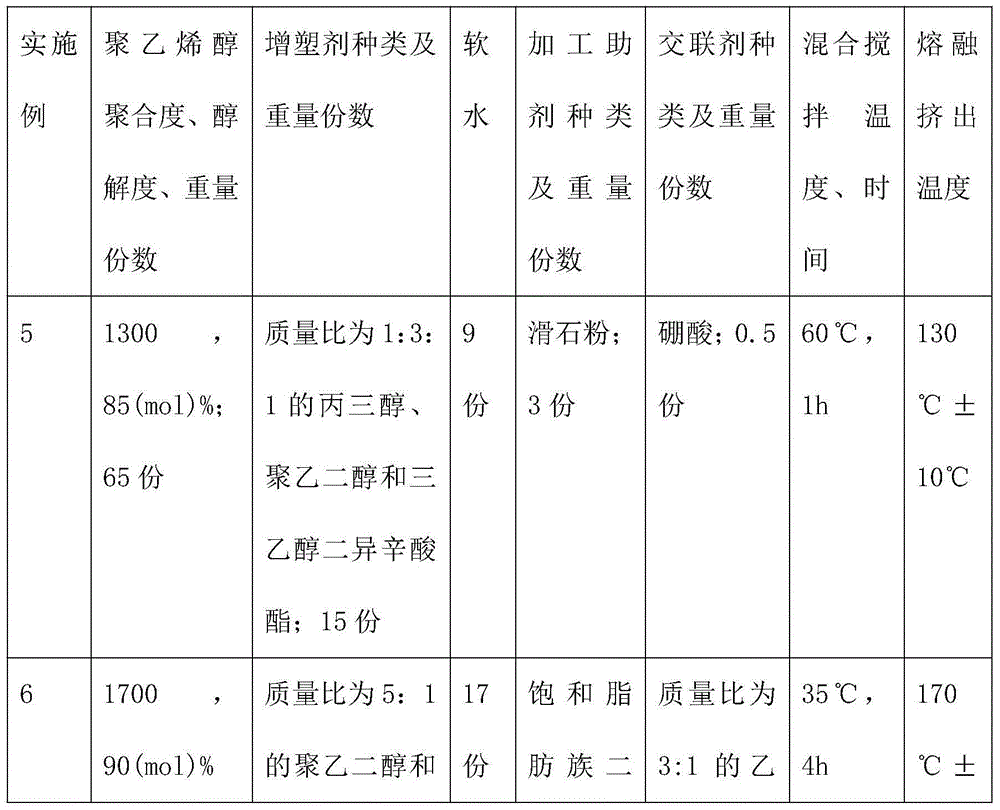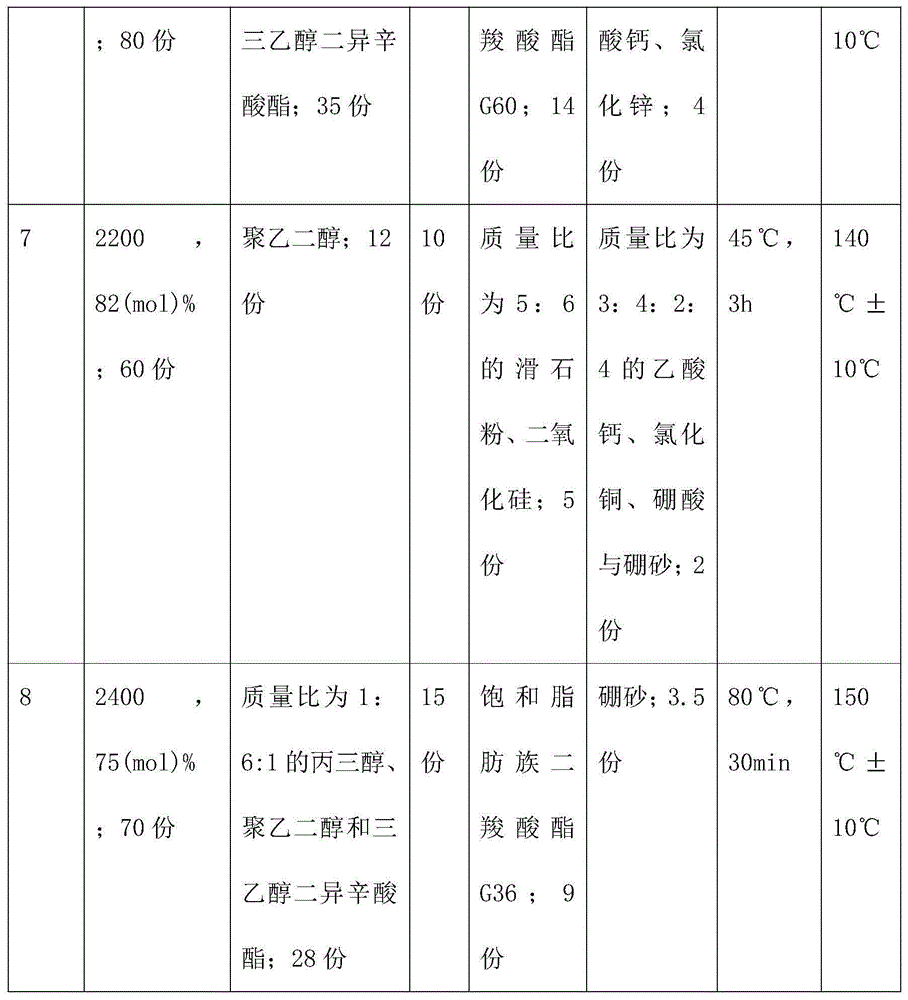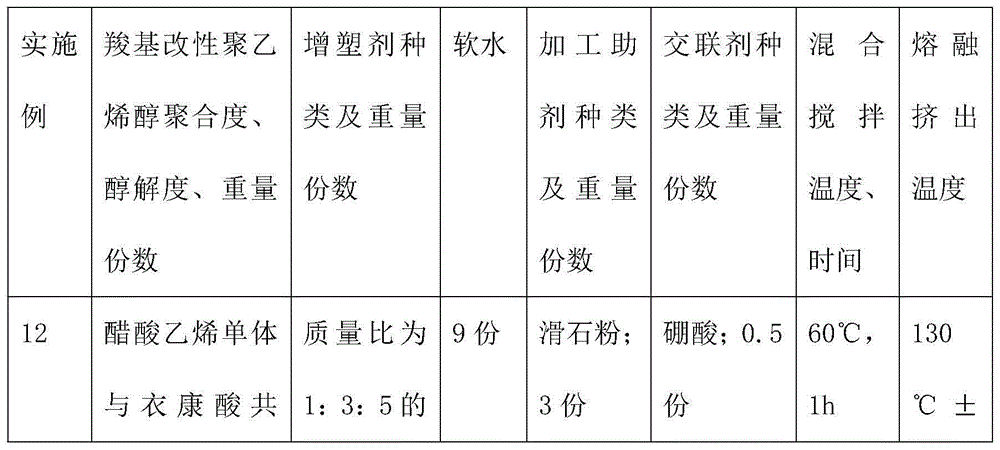Room-temperature water-soluble 3D printing consumptive material
A 3D printing, water-soluble technology, applied in the field of 3D printing consumables, can solve the problems of 3D consumables being difficult to realize, and achieve the effects of good formability, good adhesion, and environmental protection
- Summary
- Abstract
- Description
- Claims
- Application Information
AI Technical Summary
Problems solved by technology
Method used
Image
Examples
Embodiment 1
[0064] Example 1: 50 parts of polyvinyl alcohol (polymerization degree 2000, alcoholysis degree 72.0 (mol)%), 6 parts of triethanol diisooctanoate, 5 parts of soft water, 0.1 part of saturated aliphatic dicarboxylate G32 in Mix uniformly under stirring, heat while stirring at 90°C, and stop heating after 10 minutes. Then put the material into the silo with stirring, use the screw to automatically transport the material to the screw extruder, keep the screw temperature at 120°C, melt and extrude under normal pressure, then cool the material to 20°C, and cut The pelletizer is used to cut pellets to prepare a water-soluble thermoplastic polyvinyl alcohol resin at room temperature. The prepared polyvinyl alcohol resin is dried at 40°C for 10 hours, and at a temperature of 120-160°C, single-screw extrusion is used to produce water-soluble 3D printing consumables at room temperature.
[0065] The obtained 3D printing consumable has a decomposition temperature of 260°C, a melting temper...
Embodiment 2
[0066] Example 2: Mix 85 parts of polyvinyl alcohol (degree of polymerization 2400, degree of alcoholysis 88.0 (mol)%), 20 parts of glycerol, 20 parts of soft water, and 10 parts of silica, and mix them evenly under stirring. Stir while heating at 40°C, and stop heating after 10 hours. Then put the material into the silo with stirring, use the screw to automatically convey the material to the single screw extruder, keep the screw temperature at 130℃, melt and extrude under the pressure of 0.01MPa (gauge pressure), and then cool the material At 30°C, the room temperature water-soluble thermoplastic polyvinyl alcohol resin is prepared by pelletizing with a pelletizer. The prepared polyvinyl alcohol resin is dried at 80°C for 1h, and at a temperature of 140~150°C, it is made by single screw extrusion. Water-soluble 3D printing consumables at room temperature.
[0067] The resulting 3D printing consumables have a decomposition temperature of 265°C, a melting temperature of 130°C, an...
Embodiment 3
[0068] Example 3: Mix 50 parts of conventional polyvinyl alcohol (polymerization degree 1000, alcoholysis degree 90.0 (mol)%), 32 parts polyethylene glycol, 17 parts soft water, 1 part silicon dioxide, and mix well under stirring , Heat while stirring at 50℃, stop heating after 7h. Then put the material into the silo with stirring, use a single screw to automatically transport the material to the single screw extruder, keep the screw temperature at 130°C, melt and extrude under normal pressure, and then cool the material to 35°C. The room temperature water-soluble thermoplastic polyvinyl alcohol resin is prepared by pelletizing by a pelletizer. The prepared polyvinyl alcohol resin is sealed and stored, and dried at 80℃ for 5h before use. At 150℃, it is extruded by a single screw to make it at room temperature. Water-soluble 3D printing consumables.
[0069] The obtained 3D printing consumable has a decomposition temperature of 265°C, a melting temperature of 140°C, and a melt in...
PUM
| Property | Measurement | Unit |
|---|---|---|
| diameter | aaaaa | aaaaa |
| melting point | aaaaa | aaaaa |
| melt flow index | aaaaa | aaaaa |
Abstract
Description
Claims
Application Information
 Login to View More
Login to View More - R&D
- Intellectual Property
- Life Sciences
- Materials
- Tech Scout
- Unparalleled Data Quality
- Higher Quality Content
- 60% Fewer Hallucinations
Browse by: Latest US Patents, China's latest patents, Technical Efficacy Thesaurus, Application Domain, Technology Topic, Popular Technical Reports.
© 2025 PatSnap. All rights reserved.Legal|Privacy policy|Modern Slavery Act Transparency Statement|Sitemap|About US| Contact US: help@patsnap.com



